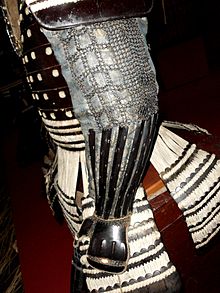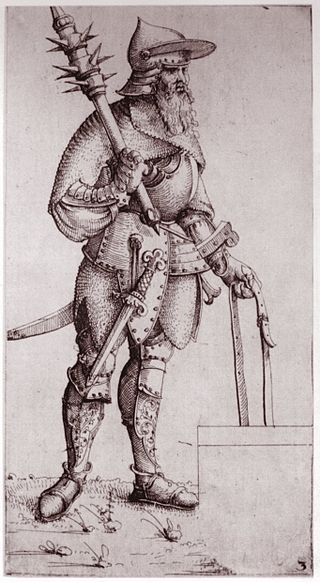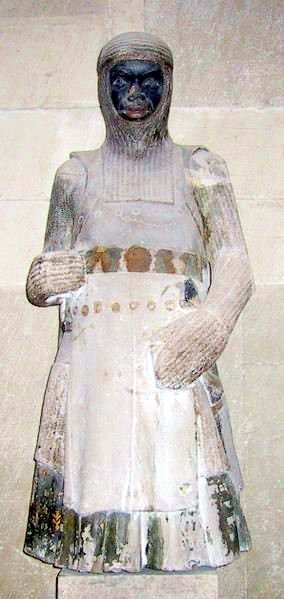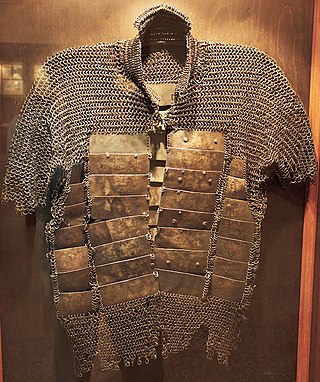
Splint armor (also splinted armour, splint armour, or splinted armor) is armor consisting of strips of metal ("splints") attached to a cloth or leather backing. It is most commonly found as limb armor such as greaves or vambraces.

Splint armor (also splinted armour, splint armour, or splinted armor) is armor consisting of strips of metal ("splints") attached to a cloth or leather backing. It is most commonly found as limb armor such as greaves or vambraces.
Limb armor consisting of strips of metal ("splints") are attached to a fabric (cloth or leather) backing ("foundation"). The splints are narrow metal strips arranged longitudinally, pierced for riveting or sewing to the foundation. Splint armor is most commonly found as greaves or vambraces.
It first appears in a Scythian grave from the 4th century BC [1] then in the Swedish Migration Era; [2] and again in the 14th century as part of transitional armour, where it was also used to form cuisses and rerebraces.

While a few complete suits of armor have been found made from splints of wood, leather, or bone, the Victorian neologism "splinted mail" usually refers to the limb protections of crusader knights. Depictions typically show it on the limbs of a person wearing mail, scale armor, a coat of plates or other plate harness.
Knights in effigy are depicted with leg protection of a matrix of disks with a diameter equal to the splints. This style appears to depict sabatons and splints on greaves, or may represent padded armour underneath splints, or the rivets on brigandine.

Armour or armor is a covering used to protect an object, individual, or vehicle from physical injury or damage, especially direct contact weapons or projectiles during combat, or from a potentially dangerous environment or activity. Personal armour is used to protect soldiers and war animals. Vehicle armour is used on warships, armoured fighting vehicles, and some combat aircraft, mostly ground attack aircraft.

Chain mail is a type of armour consisting of small metal rings linked together in a pattern to form a mesh. It was in common military use between the 3rd century BC and the 16th century AD in Europe, while it continued to be used in Asia, Africa, and the Middle East as late as the 17th century. A coat of this armour is often called a hauberk or sometimes a byrnie.

A cuirass is a piece of armour that covers the torso, formed of one or more pieces of metal or other rigid material. The word probably originates from the original material, leather, from the French cuirace and Latin word coriacea. The use of the term "cuirass" generally refers to both the breastplate and the backplate pieces; whereas a breastplate only protects the front, a cuirass protects both the front and the back of the wearer.

Lamellar armour is a type of body armour made from small rectangular plates of iron, steel, leather (rawhide), bone, or bronze laced into horizontal rows. Lamellar armour was used over a wide range of time periods in Central Asia, Eastern Asia, Western Asia, and Eastern Europe. The earliest evidence for lamellar armour comes from sculpted artwork of the Neo-Assyrian Empire in the Near East.

A greave or jambeau is a piece of armor that protects the leg.

A brigandine is a form of body armour from the late Middle Ages and up to the early Modern Era. It is a garment typically made of heavy cloth, canvas, or leather, lined internally with small oblong steel plates riveted to the fabric, sometimes with a second layer of fabric on the inside.
Korean armour is armour that was traditionally used in ancient times by Koreans, those fighting in and on behalf of Korea, or Koreans fighting overseas. Examples of armour from the Korean Peninsula date back to at least the Korean Three Kingdoms period. Depending on the tactical situation, Korean armour also included horse armour and other kinds of early anti-ballistic armour before the 20th century.

Scale armour is an early form of armour consisting of many individual small armour scales (plates) of various shapes attached to each other and to a backing of cloth or leather in overlapping rows. Scale armour was worn by warriors of many different cultures as well as their horses. The material used to make the scales varied and included bronze, iron, steel, rawhide, leather, cuir bouilli, seeds, horn, or pangolin scales. The variations are primarily the result of material availability.

A manica was a type of iron or copper-alloy laminated arm guard with curved, overlapping metal segments or plates fastened to leather straps worn by ancient and late antique heavy cavalry, infantry, and gladiators. It is most widely associated with use by the Romans, Parthians, and Achaemenid and Sasanian Persians.

Chausses were a Medieval term for leggings, which was also used for leg armour; routinely made of mail and referred to as mail chausses, or demi-chausses if they only cover the front half of the leg. They generally extended well above the knee, covering most of the leg. Mail chausses were the standard type of metal leg armour in Europe from the 9th to the early 14th centuries CE. Chausses offered flexible protection that was effective against most hand-powered weapons, but was gradually supplemented and then replaced with the development of iron plate armor for the legs in the second half of the 13th to first half of the 14th century.

Schynbalds were an early experiment in plate armour for the lower leg. Schynbalds were metal plates strapped over chausses. Each schynbald was a single piece of steel that covered the front and outside of the shin. Schynbalds did not enclose the lower leg: hence, they were not true greaves. Schynbalds first appeared in the 1230s or 1250s and remained in use during the fourteenth and fifteenth centuries.

Sangu is the term for the three armour components that protected the extremities of the samurai class of feudal Japan.
"Banded mail" is a neologism, coined in the 19th century, describing a type of composite armour formed by combining the concepts behind the Roman lorica segmentata with splint armour. Its historicity is doubtful. It has become entrenched in the popular consciousness as a result of its inclusion in the armour list for Dungeons & Dragons.

A coat of plates is a form of segmented torso armour consisting of overlapping metal plates riveted inside a cloth or leather garment. The coat of plates is considered part of the era of transitional armour and was normally worn as part of a full knightly harness. The coat saw its introduction in Europe among the warring elite in the 1180s or 1220s and was well established by the 1250s. It was in very common usage by the 1290s. By the 1350s it was universal among infantry militias as well. After about 1340, the plates covering the chest were combined to form an early breastplate, replacing the coat of plates. After 1370, the breastplate covered the entire torso. Different forms of the coat of plates, known as the brigandine and jack of plates, remained in use until the late 16th century.

Mail and plate armour is a type of mail with embedded plates. Armour of this type has been used in the Middle East, North Africa, Ottoman Empire, Japan, China, Korea, Vietnam, Central Asia, Greater Iran, India, Eastern Europe, and Nusantara.

Transitional armour describes the armour used in Europe around the 13th and 14th centuries, as body armour moved from simple mail hauberks to full plate armour.

Scholars agree that Japanese armour first appeared in the 4th century, with the discovery of the cuirass and basic helmets in graves. During the Heian period (794–1185), the unique Japanese samurai armour ō-yoroi and dō-maru appeared. The Japanese cuirass evolved into the more familiar style of body armour worn by the samurai known as the dou or dō, with the use of leather straps (nerigawa), and lacquer for weatherproofing. Leather and/or iron scales were also used to construct samurai armours, with leather and eventually silk lace used to connect the individual scales (kozane) of these cuirasses.

Kikko are small iron or hardened leather, hexagon shaped armour plates used in the construction of Japanese armor worn by samurai and ashigaru of feudal Japan.

Laminar armour is an armour made from horizontal overlapping rows or bands of, usually small, solid armour plates called lames, as opposed to lamellar armour, which is made from individual armour scales laced together to form a solid-looking strip of armour. Prominent examples of such armour are lorica segmentata of Ancient Rome and certain versions of samurai armour.
Vietnamese armour is military body armour made in the region of Vietnam.